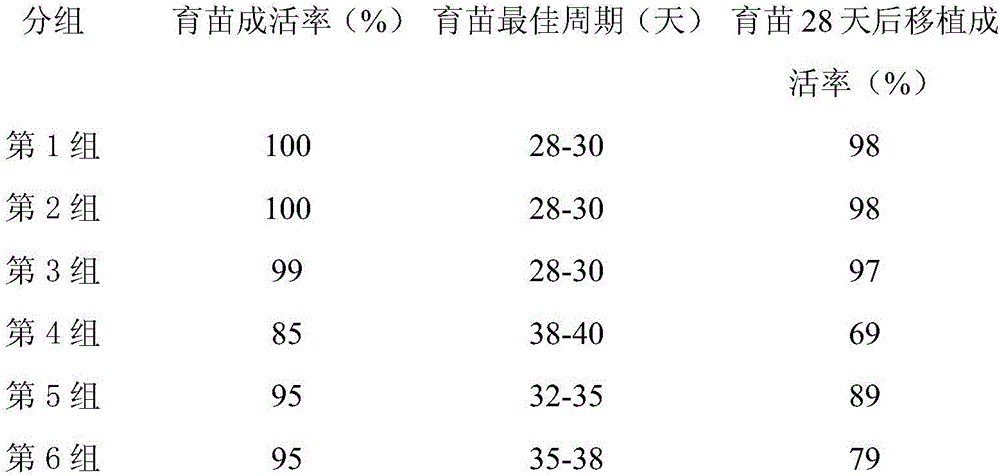Seedling growing method for lemons
A technology for growing lemon and cutting seedlings, applied in botany equipment and methods, planting substrates, preparation of organic fertilizers, etc., can solve problems such as improper management of cutting seedlings, long seedling raising cycle, and insufficient survival rate, and achieve improved survival of lemon cuttings efficiency, improve fat retention, and good ventilation
- Summary
- Abstract
- Description
- Claims
- Application Information
AI Technical Summary
Problems solved by technology
Method used
Image
Examples
Embodiment 1
[0020] A method for raising seedlings of lemons adopts the method of raising seedlings by soilless cuttings; specifically:
[0021] First, prepare a soilless substrate, take 180 parts of rabbit manure, 60 parts of mushroom residue, 20 parts of loofah vine, 40 parts of chestnut shell, 20 parts of golden sand vine, 20 parts of water calamus, 30 parts of humic acid, and compound 20 parts of strains, 120 parts of cotton stalks, 60 parts of magnesia waste porcelain powder, 120 parts of attapulgite; the compound strains are Butyricus, Ruminococcus xanthus, Giant Composition of Bacillus and filamentous fungus Trichoderma reesei. Chop the loofah vine and golden sand vine, and chop the cotton stalks into small pieces with a length less than 3cm, then mix them evenly with rabbit manure, mushroom residue, chestnut shell, and water calamus, and adjust the water content to 40% as a whole. Then mix the composite strains, ferment for 10 days at the ambient temperature of 25-30 DEG C, and fi...
Embodiment 2
[0025] A method for raising seedlings of lemons adopts the method of raising seedlings by soilless cuttings; specifically:
[0026] First, prepare a soilless substrate, take 200 parts of rabbit manure, 90 parts of mushroom residue, 30 parts of loofah vine, 50 parts of chestnut shell, 30 parts of golden sand vine, 30 parts of water calamus, 50 parts of humic acid, and compound 30 parts of strains, 150 parts of cotton stalks, 70 parts of magnesia waste porcelain powder, 150 parts of attapulgite; the composite strains are Butyricus, Ruminococcus xanthus, Giant Composition of Bacillus and filamentous fungus Trichoderma reesei. Chop the loofah vine and golden sand vine, and chop the cotton stalks into small pieces with a length less than 3cm, then mix them evenly with rabbit manure, mushroom residue, chestnut shell, and water calamus, and adjust the water content to 50% by sprinkling water. Then mix the composite strains, ferment for 15 days at the environment temperature of 25-30...
Embodiment 3
[0030] A method for raising seedlings of lemons adopts the method of raising seedlings by soilless cuttings; specifically:
[0031] First, prepare a soilless matrix, take 195 parts of rabbit manure, 88 parts of mushroom residue, 25 parts of loofah vine, 45 parts of chestnut shell, 25 parts of golden sand vine, 28 parts of water calamus, 42 parts of humic acid, and compound 25 parts of bacterial strains, 135 parts of cotton stalks, 65 parts of magnesia waste porcelain powder, and 135 parts of attapulgite; among them, the composite bacterial strains are butyrivibrio, rumenococcus xanthus, giant Composition of Bacillus and filamentous fungus Trichoderma reesei. Chop the loofah vine and golden sand vine, and chop the cotton stalks into small pieces with a length less than 3cm, then mix them evenly with rabbit manure, mushroom residue, chestnut shell, and water calamus, and adjust the water content to 45% as a whole. Then mix in the composite strains, ferment for 13 days at an amb...
PUM
 Login to View More
Login to View More Abstract
Description
Claims
Application Information
 Login to View More
Login to View More - R&D
- Intellectual Property
- Life Sciences
- Materials
- Tech Scout
- Unparalleled Data Quality
- Higher Quality Content
- 60% Fewer Hallucinations
Browse by: Latest US Patents, China's latest patents, Technical Efficacy Thesaurus, Application Domain, Technology Topic, Popular Technical Reports.
© 2025 PatSnap. All rights reserved.Legal|Privacy policy|Modern Slavery Act Transparency Statement|Sitemap|About US| Contact US: help@patsnap.com

